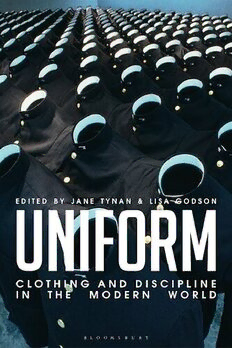
Uniform: Clothing and Discipline in the Modern World PDF
321 Pages·2019·14.467 MB·English
Most books are stored in the elastic cloud where traffic is expensive. For this reason, we have a limit on daily download.
Preview Uniform: Clothing and Discipline in the Modern World
Description:
Uniform: Clothing and Discipline in the Modern World examines the role uniform plays in public life and private experience. This volume explores the social, political, economic, and cultural significance of various kinds of uniforms to consider how they embody gender, class, sexuality, race, nationality, and belief. From the pageantry of uniformed citizens to the rationalizing of time and labour, this category of dress has enabled distinct forms of social organization, sometimes repressive, sometimes utopian. With thematic sections on the social meaning of uniform in the military, in institutions, and political movements, its use in fashion, in the workplace, and at leisure, a series of case studies consider what sartorial uniformity means to the history of the body and society.Ranging from English public school uniform to sacred dress in the Vatican, from Australian airline uniforms to the garb worn by soldiers in combat, Uniform draws attention to a visual and material practice with the power to regulate or disrupt civil society. Bringing together original research from emerging and established academics, this book is essential reading for students and scholars of fashion, design, art, popular culture, anthropology, cultural history, and sociology, as well as anyone interested in what constitutes a “modern” appearance.This edited volume considers new ways of thinking about uniform as an embodied social practice; it brings together a range of essays that explore the social, cultural and political significance of regulatory clothing in various settings. The book traces the expansion of uniform as a mode of self-presentation, focusing on the period from the mid-nineteenth century when this form of clothing became a key motif in public life. The collection draws together a range of perspectives on the topic, from established and emerging scholars in sociology, art and design history, anthropology, fashion history, politics, law and international relations. Uniform is revealed as a technique to both display and obscure the sources of social and political power. From political movements, to religion, leisure, fashion and sports, the book also covers transport, military and school uniforms in various regions. Uniform offers a complex and exciting set of interconnections between militarism and pleasure, democracy and fashion, work and leisure, mobility and power, consumerism and citizenship. What emerges from the collection of essays is a sense that uniform codes are not static and even as uniform styles become meaningful to institutional settings they continually undergo symbolic transformations. As they are manipulated and subverted in art, fashion and popular culture uniform codes remain remarkably resilient and endure in ever more inventive forms into the twenty-first century. The interdisciplinary approach of the book draws attention to the variety of ways in which uniform as a category of dress has enabled distinct forms of social organization in modernity and postmodernity.
See more
The list of books you might like
Most books are stored in the elastic cloud where traffic is expensive. For this reason, we have a limit on daily download.
